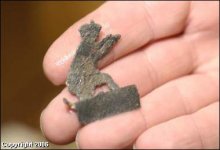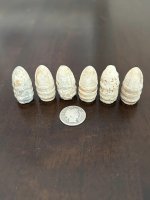DETREASUREHNTR
Full Member
Artifacts helping to solve wreck mystery
By MOLLY MURRAY
The News Journal
07/11/2006
Sometime on June 14, 1774, the sailing vessel Severn, en route from Bristol, England, to Philadelphia, ran aground in Delaware Bay and filled with water.
The crew was saved, but the cargo and ship were lost.
That cargo may be what a dredge struck more than a year ago as the U.S. Army Corps of Engineers pumped sand from an offshore bar onto the beach near Roosevelt Inlet in Lewes.
The beach replenishment project, completed in the fall of 2004, uncovered thousands of pieces of pottery, glass, toy soldiers and even fake clocks. It also captured the imagination of hundreds of beachcombers who have turned over thousands of shards of history to state historians and archaeologists for study.
Historians working on the mass of glass, pottery and metal collected from Lewes Beach now believe the ship could be the Severn.
The other likely possibility is the Commerce, which sank en route from the British port of Hull to New York on Jan. 4, 1771.
"The ship and the greatest part of the cargo will be lost," according to historical records.
The two vessels fit the time frame suggested by the vast collection of artifacts and the size and length of the ship -- estimated to be 85 to 90 feet long.
State archaeologists hope to gather more clues to the ship's identity later this summer when they plan a second dive on the offshore wreck site, said Daniel R. Griffith, project director for the state's Lewes Maritime Archaeology Program.
In April, Griffith applied to have the wreck site listed on the National Register of Historic Places.
Although the wreck is not as old as originally thought, it is still the oldest discovered in Delaware waters. And it has historic significance well beyond Delaware, Griffith said.
"It's the last vestige of British mercantilism," he said. At the time the ship was lost, "no one else was allowed to trade with our colonies."
When the ship went down -- sometime between 1769 and 1775, Delaware was part of the Pennsylvania colony and still governed by Great Britain. The immigrant population was growing in the Philadelphia area and the economy expanded. By 1772, Philadelphia became the most important colonial port -- exceeding both Boston and New York.
Griffith said that goods were available from other parts of Europe, but Great Britain was an effective middle man. Everything that was shipped to the colonies went through a British port first.
Clues to history
What is just off the beach may yield important historic clues to how the British colonial economic system worked.
"We know from diving that about 80 percent of the site is left," Griffith said.
Archaeologists believe the dredge hit near the bow of the ship but did little damage amidships or in the stern, where the captain's quarters would have been, he said.
One goal is to try to find out more about shipboard life by looking at the galley and crew quarters.
In addition, state officials hope to find out more about the cargo. Light goods would have been kept in the bow of the ship. The main cargo hold would have been in the stern, Griffith said.
Over the last year, historians and archaeologists have been culling through thousands of bits and pieces that were collected by beachcombers.
In all, they have some 43,000 pieces brought in by 143 donors.
Donations are still coming in. Two weeks ago, for instance, a couple came in with a few pieces of pottery. Among them was a shard that bore the British royal crest of King George. It was the first artifact of that type the historians and archaeologists had seen from the Lewes wreck site.
One of the most interesting discoveries made so far is the identity of a mysterious green and yellow glazed piece of pottery found on the beach.
Initially, state archaeologists believed this earthenware was very old -- possibly from the late 17th or early 18th century.
Now they've concluded the pottery is called Frankfurter Ware and was made in the 1760s in the Rhine Valley in Germany.
The pottery, Griffith said, was very popular in Holland. It was also popular with immigrants in the Philadelphia region because about 40 percent of the population in the area was German, Griffith said.
That might also explain the abundance of seltzer water bottles that were recovered in fragments from the beach. "In Europe, everybody drank it," Griffith said. But "it's never been seen before in North America" from other artifact-rich sites.
Artifacts raise questions
Among the mysteries of the artifacts are the glazed bricks that were found on the beach.
Griffith said some experts believe the only colonists that still would have used the distinctive yellow bricks would have been Pennsylvania Dutch settlers.
In the end, Griffith said, out of the 43,000 artifacts, dating the wreck site came down to four pieces.
Three of those pieces were Dutch tobacco pipes complete with makers marks that were used to narrow the date of the shipwreck to a time beginning in 1769 and ending in 1775. What is missing from the pottery collection is pearlware, which didn't start to show up until the 1780s, Griffith said.
That information, along with the fact that the British blockaded shipping starting in 1775, are all important clues that state officials used to date the wreck site.
They hope to find out more when divers resume work at the wreck site later this summer.
Contact Molly Murray at 856-7372 or [email protected].
News Journal file
This toy soldier was one of 43,000 pieces found on Lewes beaches.
By MOLLY MURRAY
The News Journal
07/11/2006
Sometime on June 14, 1774, the sailing vessel Severn, en route from Bristol, England, to Philadelphia, ran aground in Delaware Bay and filled with water.
The crew was saved, but the cargo and ship were lost.
That cargo may be what a dredge struck more than a year ago as the U.S. Army Corps of Engineers pumped sand from an offshore bar onto the beach near Roosevelt Inlet in Lewes.
The beach replenishment project, completed in the fall of 2004, uncovered thousands of pieces of pottery, glass, toy soldiers and even fake clocks. It also captured the imagination of hundreds of beachcombers who have turned over thousands of shards of history to state historians and archaeologists for study.
Historians working on the mass of glass, pottery and metal collected from Lewes Beach now believe the ship could be the Severn.
The other likely possibility is the Commerce, which sank en route from the British port of Hull to New York on Jan. 4, 1771.
"The ship and the greatest part of the cargo will be lost," according to historical records.
The two vessels fit the time frame suggested by the vast collection of artifacts and the size and length of the ship -- estimated to be 85 to 90 feet long.
State archaeologists hope to gather more clues to the ship's identity later this summer when they plan a second dive on the offshore wreck site, said Daniel R. Griffith, project director for the state's Lewes Maritime Archaeology Program.
In April, Griffith applied to have the wreck site listed on the National Register of Historic Places.
Although the wreck is not as old as originally thought, it is still the oldest discovered in Delaware waters. And it has historic significance well beyond Delaware, Griffith said.
"It's the last vestige of British mercantilism," he said. At the time the ship was lost, "no one else was allowed to trade with our colonies."
When the ship went down -- sometime between 1769 and 1775, Delaware was part of the Pennsylvania colony and still governed by Great Britain. The immigrant population was growing in the Philadelphia area and the economy expanded. By 1772, Philadelphia became the most important colonial port -- exceeding both Boston and New York.
Griffith said that goods were available from other parts of Europe, but Great Britain was an effective middle man. Everything that was shipped to the colonies went through a British port first.
Clues to history
What is just off the beach may yield important historic clues to how the British colonial economic system worked.
"We know from diving that about 80 percent of the site is left," Griffith said.
Archaeologists believe the dredge hit near the bow of the ship but did little damage amidships or in the stern, where the captain's quarters would have been, he said.
One goal is to try to find out more about shipboard life by looking at the galley and crew quarters.
In addition, state officials hope to find out more about the cargo. Light goods would have been kept in the bow of the ship. The main cargo hold would have been in the stern, Griffith said.
Over the last year, historians and archaeologists have been culling through thousands of bits and pieces that were collected by beachcombers.
In all, they have some 43,000 pieces brought in by 143 donors.
Donations are still coming in. Two weeks ago, for instance, a couple came in with a few pieces of pottery. Among them was a shard that bore the British royal crest of King George. It was the first artifact of that type the historians and archaeologists had seen from the Lewes wreck site.
One of the most interesting discoveries made so far is the identity of a mysterious green and yellow glazed piece of pottery found on the beach.
Initially, state archaeologists believed this earthenware was very old -- possibly from the late 17th or early 18th century.
Now they've concluded the pottery is called Frankfurter Ware and was made in the 1760s in the Rhine Valley in Germany.
The pottery, Griffith said, was very popular in Holland. It was also popular with immigrants in the Philadelphia region because about 40 percent of the population in the area was German, Griffith said.
That might also explain the abundance of seltzer water bottles that were recovered in fragments from the beach. "In Europe, everybody drank it," Griffith said. But "it's never been seen before in North America" from other artifact-rich sites.
Artifacts raise questions
Among the mysteries of the artifacts are the glazed bricks that were found on the beach.
Griffith said some experts believe the only colonists that still would have used the distinctive yellow bricks would have been Pennsylvania Dutch settlers.
In the end, Griffith said, out of the 43,000 artifacts, dating the wreck site came down to four pieces.
Three of those pieces were Dutch tobacco pipes complete with makers marks that were used to narrow the date of the shipwreck to a time beginning in 1769 and ending in 1775. What is missing from the pottery collection is pearlware, which didn't start to show up until the 1780s, Griffith said.
That information, along with the fact that the British blockaded shipping starting in 1775, are all important clues that state officials used to date the wreck site.
They hope to find out more when divers resume work at the wreck site later this summer.
Contact Molly Murray at 856-7372 or [email protected].
News Journal file
This toy soldier was one of 43,000 pieces found on Lewes beaches.





